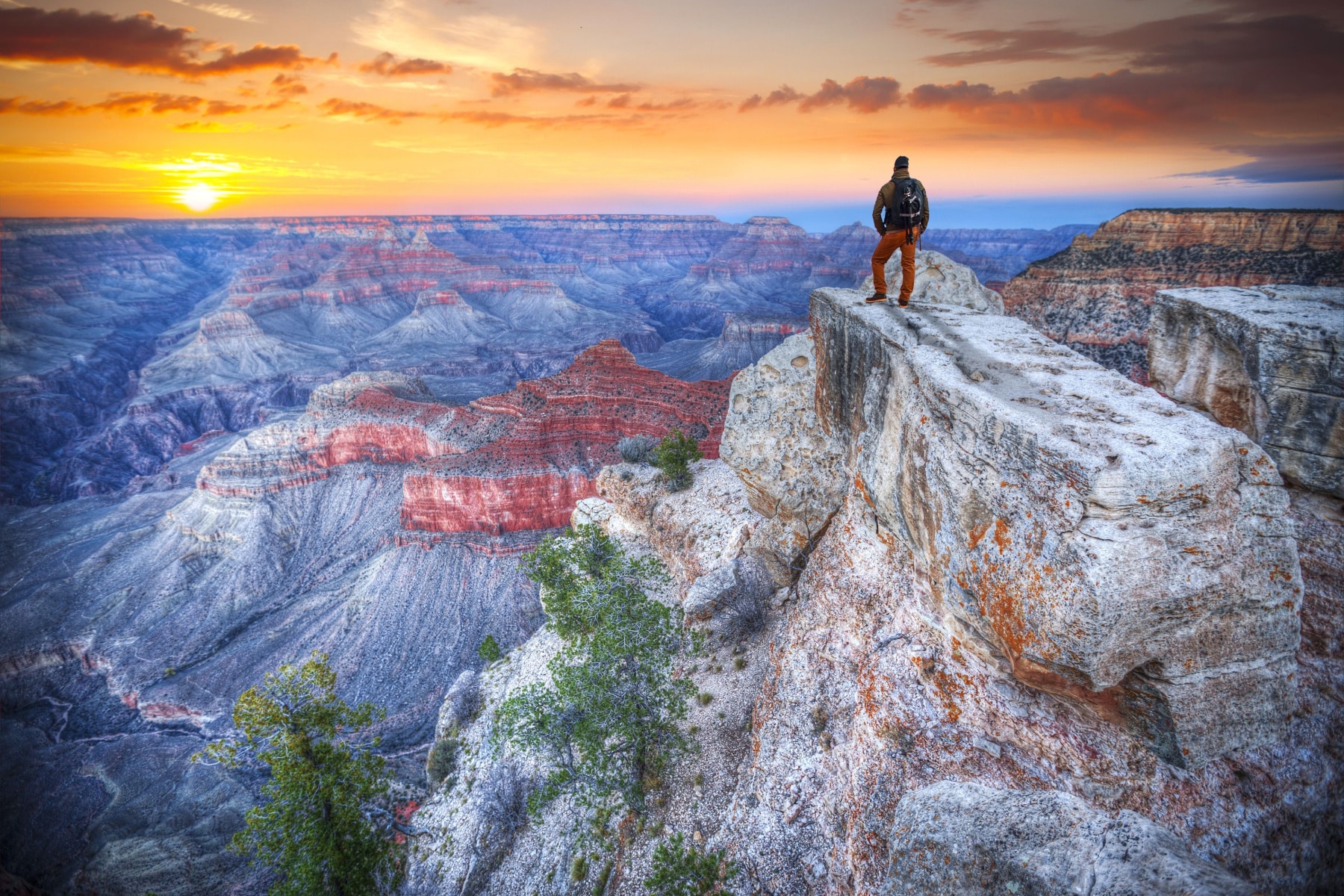
Article Overview: Best Hikes Grand Canyon
The best hikes in the Grand Canyon offer sky-high and river-level opportunities to enjoy the grandeur of one of the world’s greatest wonders. You don’t need to tackle the rigorous rim-to-rim trail to enjoy the views. Easy hikes in the Grand Canyon aren’t hard to find.
Consider this a smorgasbord of hiking options, from the best day hikes in the Grand Canyon to trails on the South Rim and the less crowded North Rim. I’ve hiked the Grand Canyon from both rims and can help you plan the hikes, from Bright Angel Trail to South Kaibab Trail while uncovering some of the lesser-known stunning scenic vistas.
Prepare to lace up your hiking boots straightaway because we’re about to walk you through the 15 Best Hikes in Grand Canyon National Park!
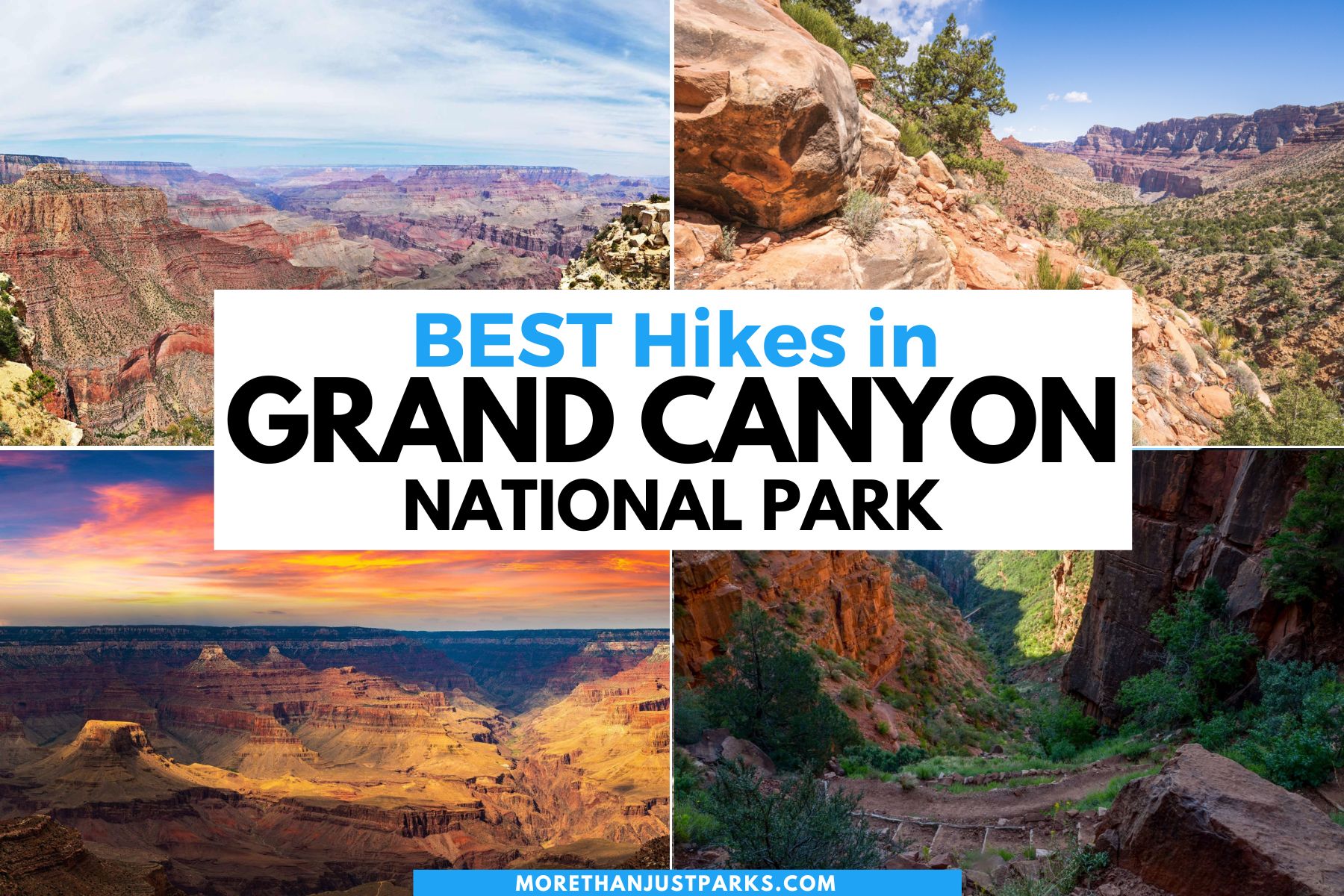
Best Hikes Grand Canyon
Table of Contents: Best Hikes Grand Canyon
Table of contents
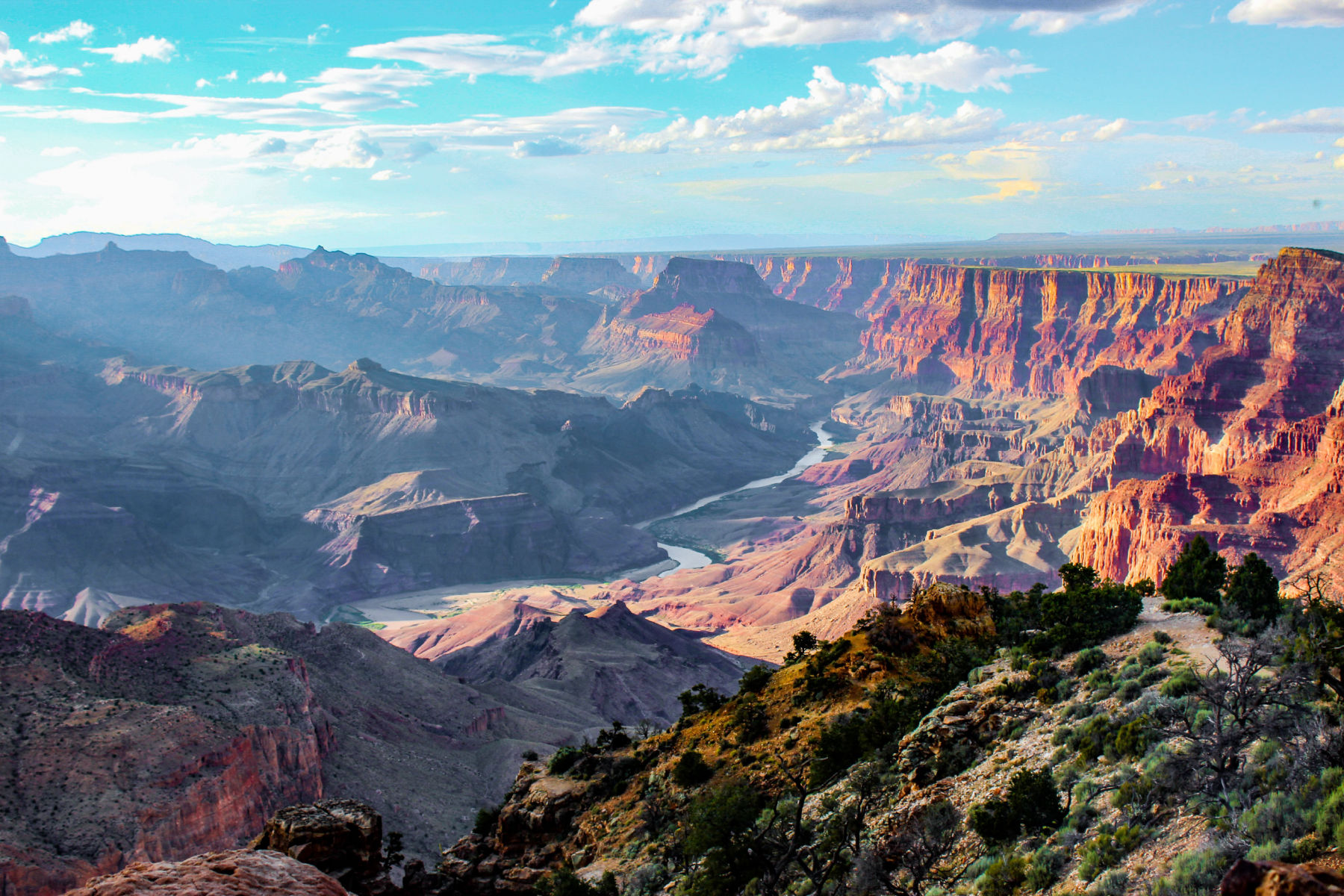
5 Quick Things About Visiting Grand Canyon National Park
- The entrance fee is $20 per person or $35 per car, valid for seven days. First, check to see if you qualify for a free National Park access pass.
- No matter what time of year, bring sunscreen and reapply often. We like Thinksport SPF 50 for how it holds up during physical activity and the eco-friendly ingredients.
- I like this map best for Grand Canyon National Park, especially since mobile service is spotty. You might also want to bring a guidebook with you. I’d also recommend using a thermal cover for your mobile device to protect it from overheating, freezing, or breaking.
- If you’re looking for a place to stay near the South Rim, we always opt for The Grand Hotel outside the park, but you can choose one of the options inside the park. On the North Rim, you only have the Grand Canyon Lodge option inside the park.
- The North Rim closes from mid-October to mid-May. However, if you just want to hike, you can still drive in through December 1. You just won’t have services available. Always check the Park Conditions before planning a hike on either rim.

Safety Preps for Best Hikes Grand Canyon
The best hikes in the Grand Canyon are safe hikes. Here’s some helpful information you’ll need before choosing our Grand Canyon day hike or longer adventure.
Permit vs. Day Hikes
You do not need a permit for hiking the Grand Canyon as long as it’s a day hike. However, listen to all park suggestions about not taking a hike from the rim to the river or rim to rim in one day.
Backcountry hikes (camping) do require a permit issued through a lottery, however.
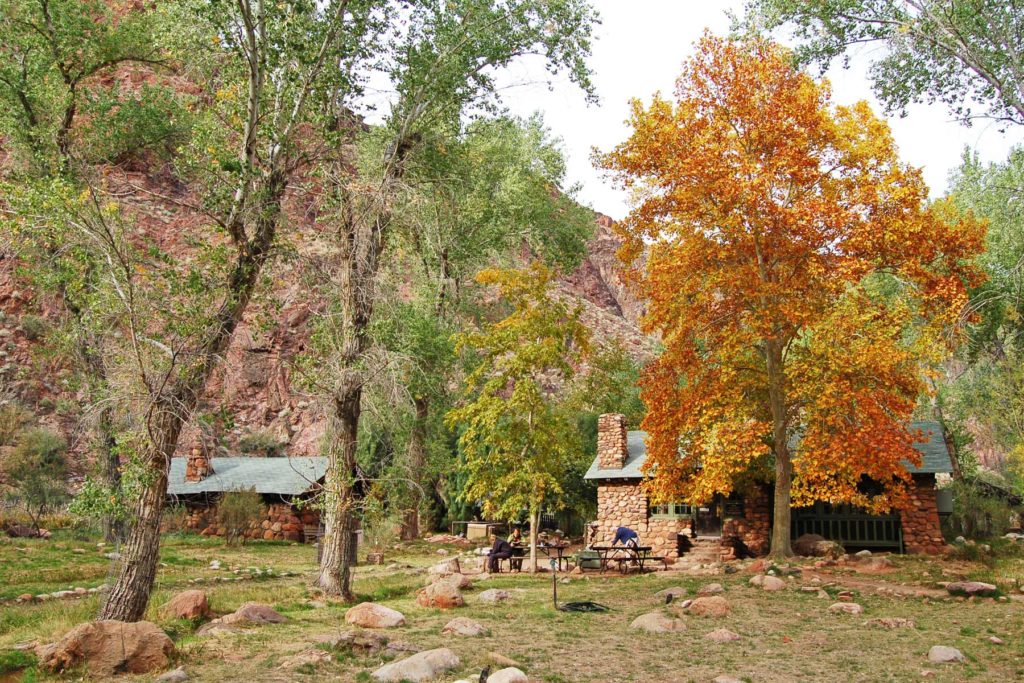

Water. Water. Water.
Only a handful of trails, like Bright Angel Trail, have potable water on the trail. Emphatically, I tell you – you should never rely on that water supply.
Above all, have one gallon of water for a hike and a way to treat spring water.
Weather
Certainly, check the weather and temperature forecast before you plan a hike. Summer monsoons bring flash flooding and lightning dangers at least a few times a week.
Expect a 5-6°F change in temperatures for every 1,000 feet you descend or ascend. For that reason, the canyon floor easily reaches triple digits in the summer by noon, if not earlier.
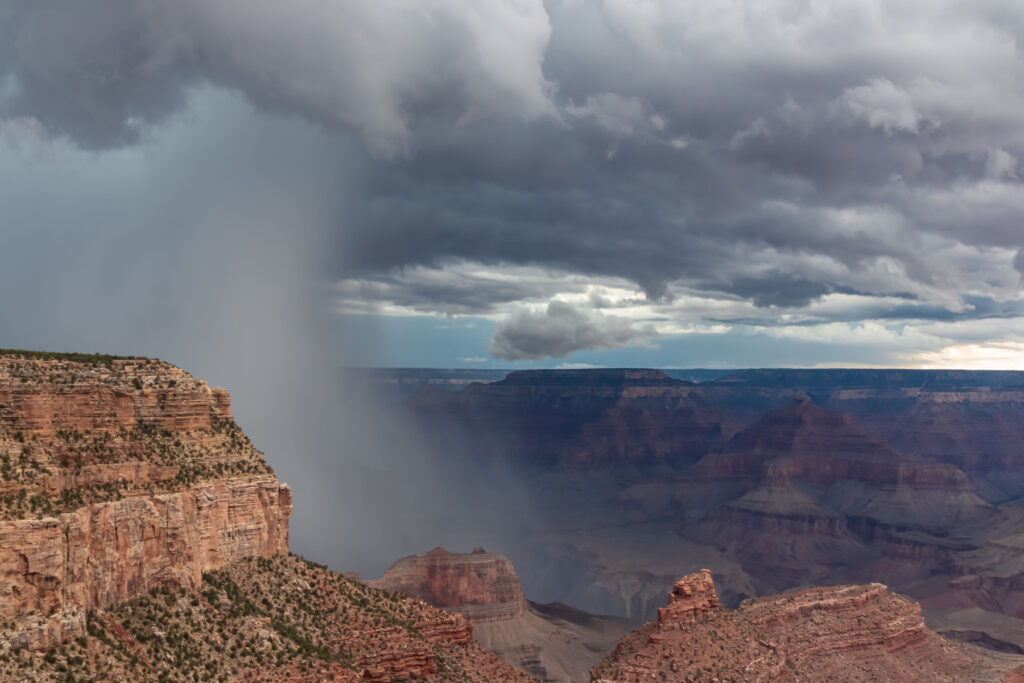
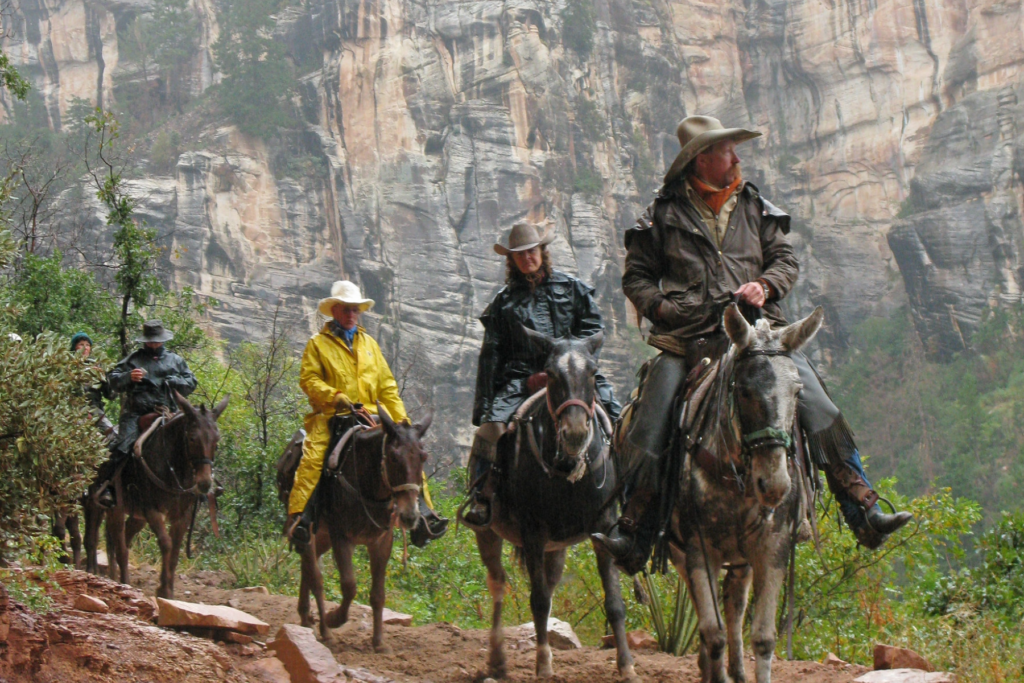
Mules
Finally, some of the best hikes in the Grand Canyon are shared with mule riders, like Bright Angel Trail and North Kaibab Trail.
The first thing to remember is that mule groups always have the right of way, and you might see some mule droppings left behind on the trail.
Top 15 Best Hikes in the Grand Canyon
15. Transept Trail
Location: North Rim
- Distance: 3 miles round-trip
- Difficulty: Easy to Moderate
- Elevation Change: 347 ft
- Time Required: Approximately 1.5 hours round-trip
The Transept Trail is an out-and-back route with a length of roughly three miles or so. With a minimal elevation change of 347 feet, this is unquestionably one of the best hikes in the Grand Canyon for beginners. You’ll still face some steep drops shortly after beginning.
The trail offers easy terrain (by Grand Canyon standards) and ample opportunities to admire the breathtaking beauty of the Grand Canyon. Along the way, there are various spots where hikers can walk closer to the edge, taking selfies and panoramic photos and enjoying the magnificent views.
The round trip time, on the whole, is about 1.5 hours, so the Transept Trail provides a manageable excursion for those exploring the North Rim area.
TRAVEL TIP: For a longer hiker with more views, pair the Transept Trail together with Bright Angel Point and Bridle Trail. This will be a 4.5-mile hike with one of the best views of the Grand Canyon on the North Rim.
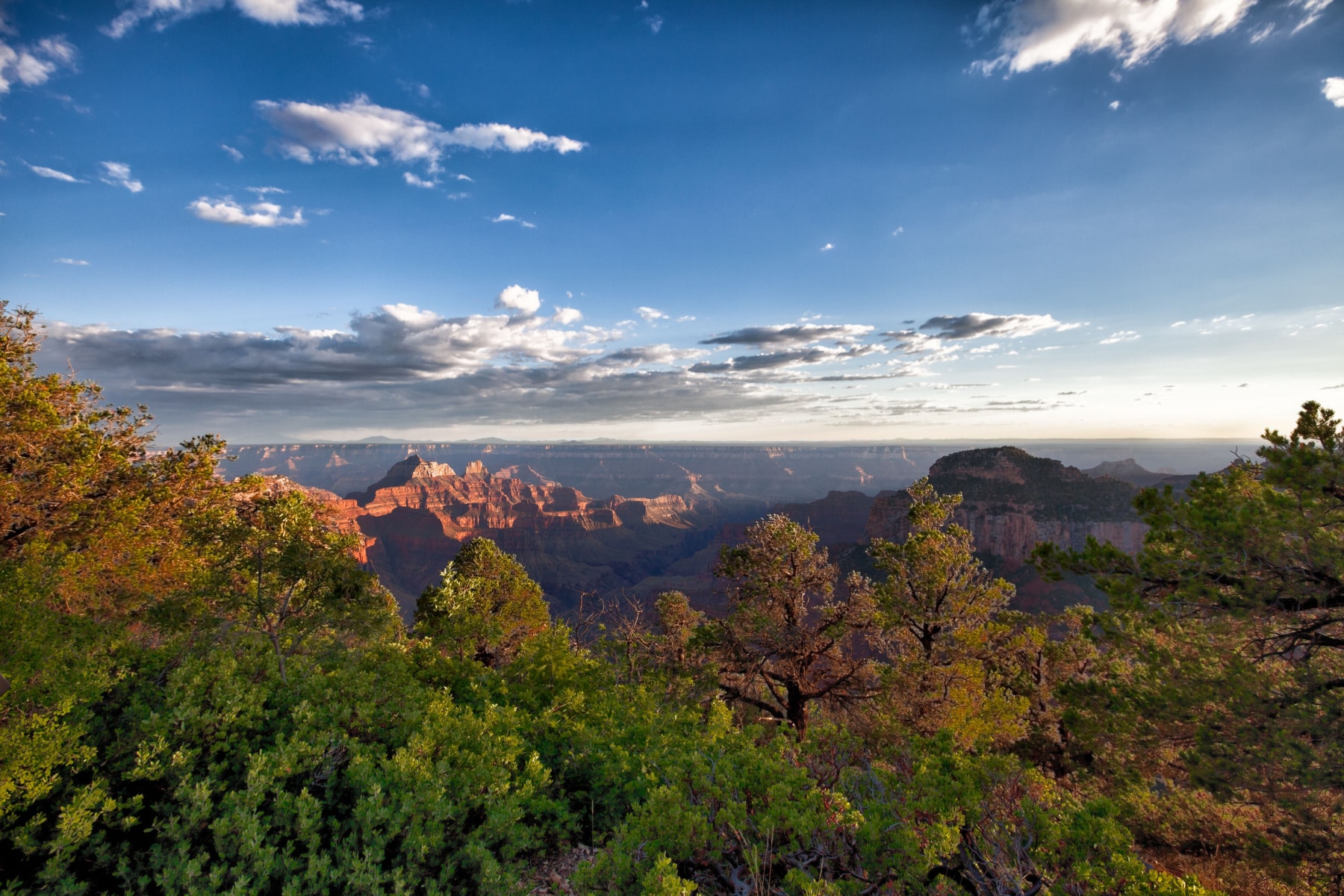
14. Tanner Trail
Location: South Rim
- Distance: 14.3 miles roundtrip
- Difficulty: Strenuous
- Elevation Change: 5,416 ft
- Time Required: Around 8-10 hours
The Tanner Trail is one of the best hikes on the South Rim of the Grand Canyon for experienced hikers. As a matter of fact, even the people who run the park think it’s the toughest. While other rim-to-river trails were influenced by humans, additionally, this trail is a natural path to the river and access to the easternmost section of the canyon.
The Tanner Trail is unmaintained and ranks as one of the most difficult and demanding south side trails, but for an experienced canyon walker the
Grand Canyon NPS
aesthetic bounty of the area will be adequate compensation.
On the other hand, the Tanner trail has an upper section that is narrow, badly eroded, and hard to follow, especially after winter storms. Rock slides have covered parts of the original trail, requiring improvisation – so please be careful and take your time!
If you can make it, you’ll see breathtaking views, to say nothing of the beautiful sunsets. The Tanner Trail awaits those seeking a difficult – but worth it – adventure.
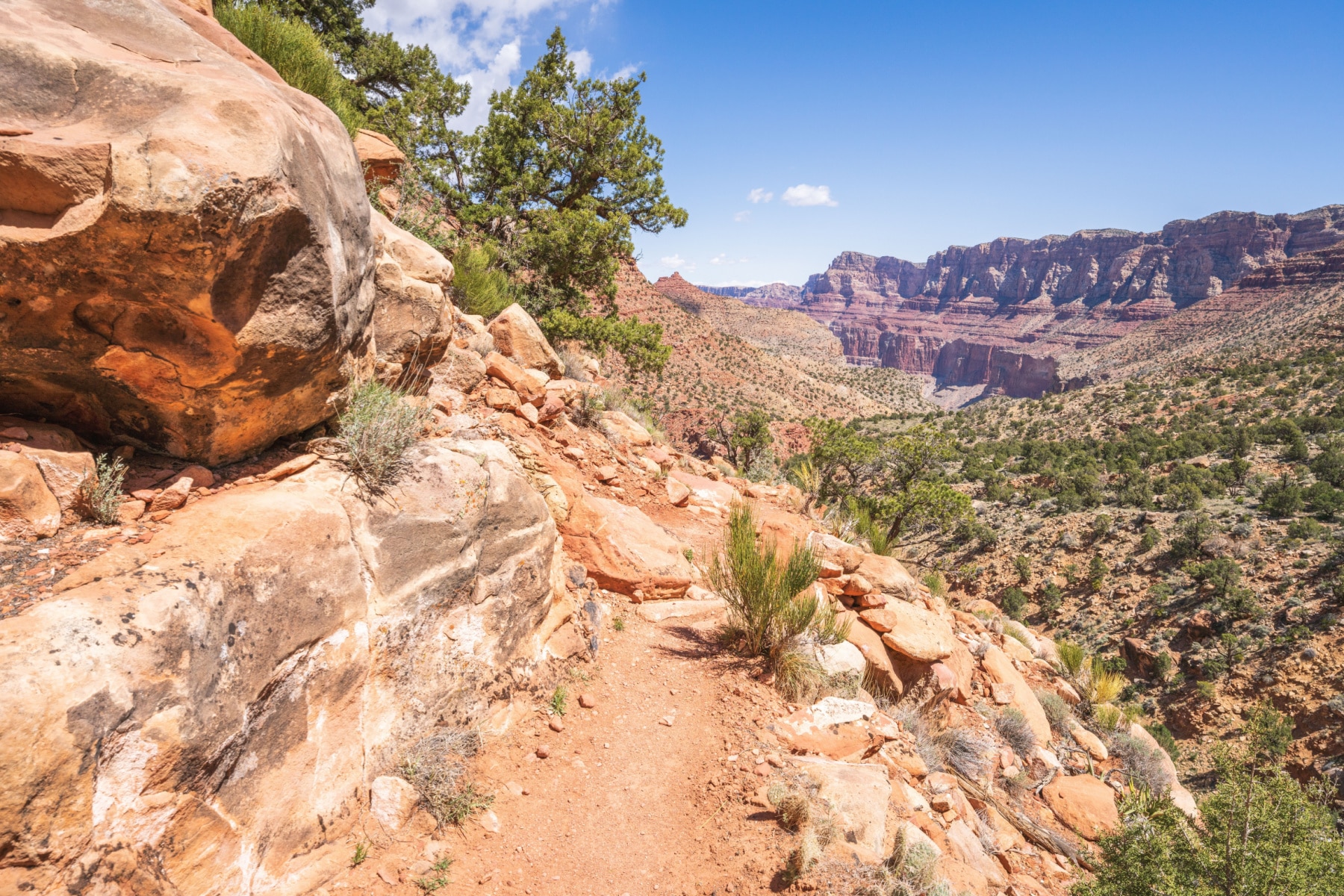
13. Bridle Trail
Location: North Rim near North Kaibab Trailhead
- Distance: 2.5 miles round-trip
- Difficulty: Easy to Moderate
- Elevation Change: 259 ft
- Time Required: 1 hour round-trip
The Bridle Trail is, without a doubt, a convenient and accessible trail that follows the road connecting the Grand Canyon Lodge with the North Kaibab Trailhead. With a distance of 1.2 miles one-way, this trail provides a straightforward route for hikers to navigate. This is one of the best hikes in the Grand Canyon for those traveling with pets. At this time, it’s also one of the only hikes where pets are allowed.
Additionally, the Bridle Trail has a hard-packed surface, making it more stable and relatively easy. With this in mind, if you prefer to explore on two wheels, bicycles are also allowed on this trail!
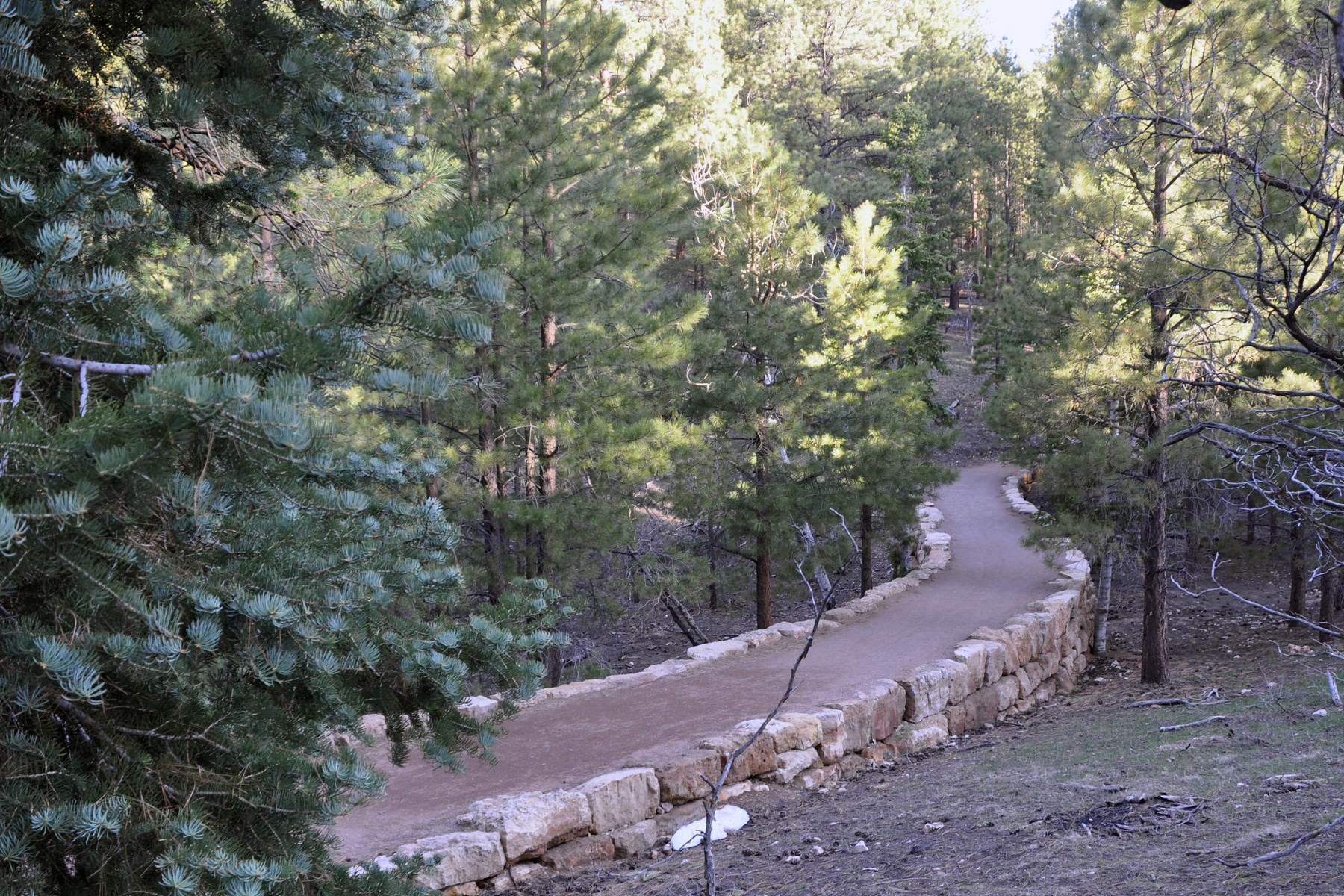
12. Ken Patrick Trail
Location: North Rim
- Distance: 9.8 miles one-way
- Difficulty: Moderate
- Elevation Change: 1,269 ft
- Time Required: 4 hours
The Ken Patrick Trail is one of the best hikes in the Grand Canyon for being alone. It’s the least-used trail on the least visited rim, and it’s a wonderful rim walk to the highest point of the North Rim.
Moreover, the breathtaking views of the North Rim and diverse terrains make it all worth it. However, to do it as a Grand Canyon day hike, you have to shuffle some cars. To begin with, the trailhead starts at the North Kaibab Trailhead parking lot and goes to the Point Imperial parking lot. What’s more, Point Imperial stands as the tallest point on the North Rim at 8,803 feet.
You’ll need a ride ready at Point Imperial to take the nine-mile drive back to the trailhead, given that there is no shuttle service on the North Rim.

Who was Ken Patrick?
Ken Patrick grew up in the Grand Canyon. His father ran the Phantom Ranch. In fact, Ken’s career took him to the Arizona Department of Public Safety, Organ Pipe Cactus National Monument, and Point Reyes National Seashore.
It was at the seashore his end of watch came on August 5, 1973, when he approached deer poachers.
His killers were part of the Black Panthers organization and, in time, were caught and convicted of several crimes, including murder.
“May the memory of his devotion to all people and to that fine country of our national parks and the splendor of his soul inspire and remain with us.” – On Patrick’s tombstone

11. Uncle Jim Trail
Location: North Kaibab Trail Parking Lot in the North Rim
- Distance: 5 miles round-trip
- Difficulty: Easy
- Elevation Change: 731 ft
- Time Required: 3 hours round-trip
The Uncle Jim Trail is one of the best hikes Grand Canyon’s North Rim offers for those riding a mule. In any event, whether you take the trail on two or four feet, you’ll start on the Ken Patrick Trail and then turn onto Uncle Jim Trail, which loops with a stop at Uncle Jim Overlook.
Since you’re probably anxious to know, let me introduce you to Uncle Jim.
Who is Uncle Jim? Uncle Jim Owens was the first game warden of the Grand Canyon Game Preserve (a precursor to the park we know today) in 1906. At the same time, he led hunting expeditions with many people, including President Teddy Roosevelt. Here’s in-depth information about Uncle Jim if you’re intrigued.
At any rate, you should know that history to understand why much of this trail is through tall, dense woods with some gutted sections as a result of wildfires. Otherwise, you might think I’ve sent you to a flat, boring trail. After that walk through the woods, you’ll come upon an amazing view of the canyon and the switchbacks on the North Kaibab Trail.
At the same time, you’ll likely have the trail to yourself compared to other North Rim hikes.
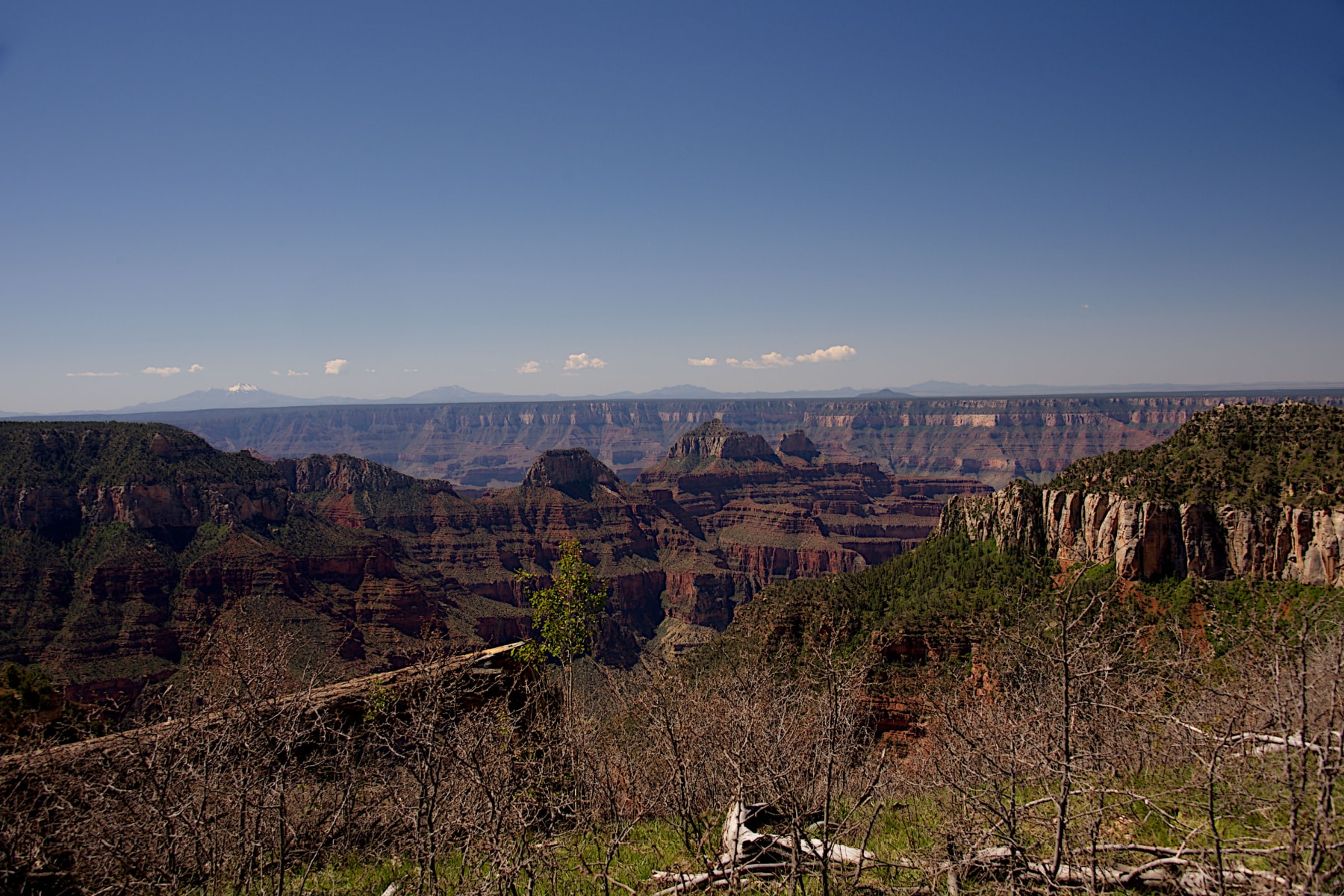
10. Widforss Trail
Location: North Rim
- Distance: 10 miles round-trip
- Difficulty: Moderate
- Elevation Change: 1,082 ft
- Time Required: 5 hours round-trip
The Widforss Trail offers a markedly magnificent rim hike, allowing you to appreciate the beauty of the surrounding forest. With this in mind, the trail is one of the best hikes in the Grand Canyon for forestry, wildlife, and ponderosa pines.
As can be seen in this brochure, many elements of the forest are worth noting. For example, the Kaibab squirrel is only found in the North Rim region.
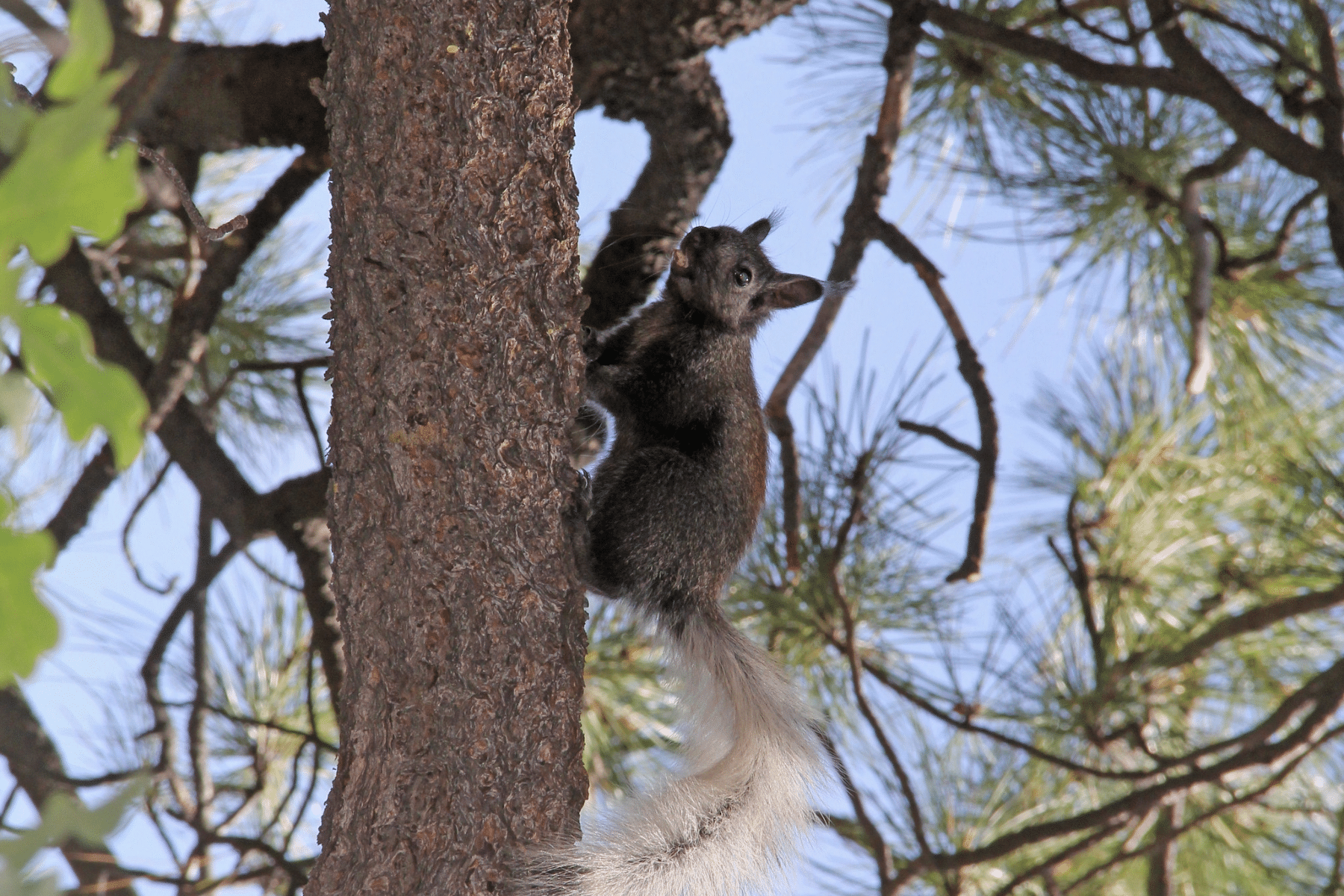
Secondly, one of the world’s largest ponderosa pines is on this trail. Finally, you’ll get great views of The Transept side canyon.
The trail weaves seamlessly from the rim into the forest throughout the hike. Additionally, if you visit in the fall, the forest portion glows aspens are in season.
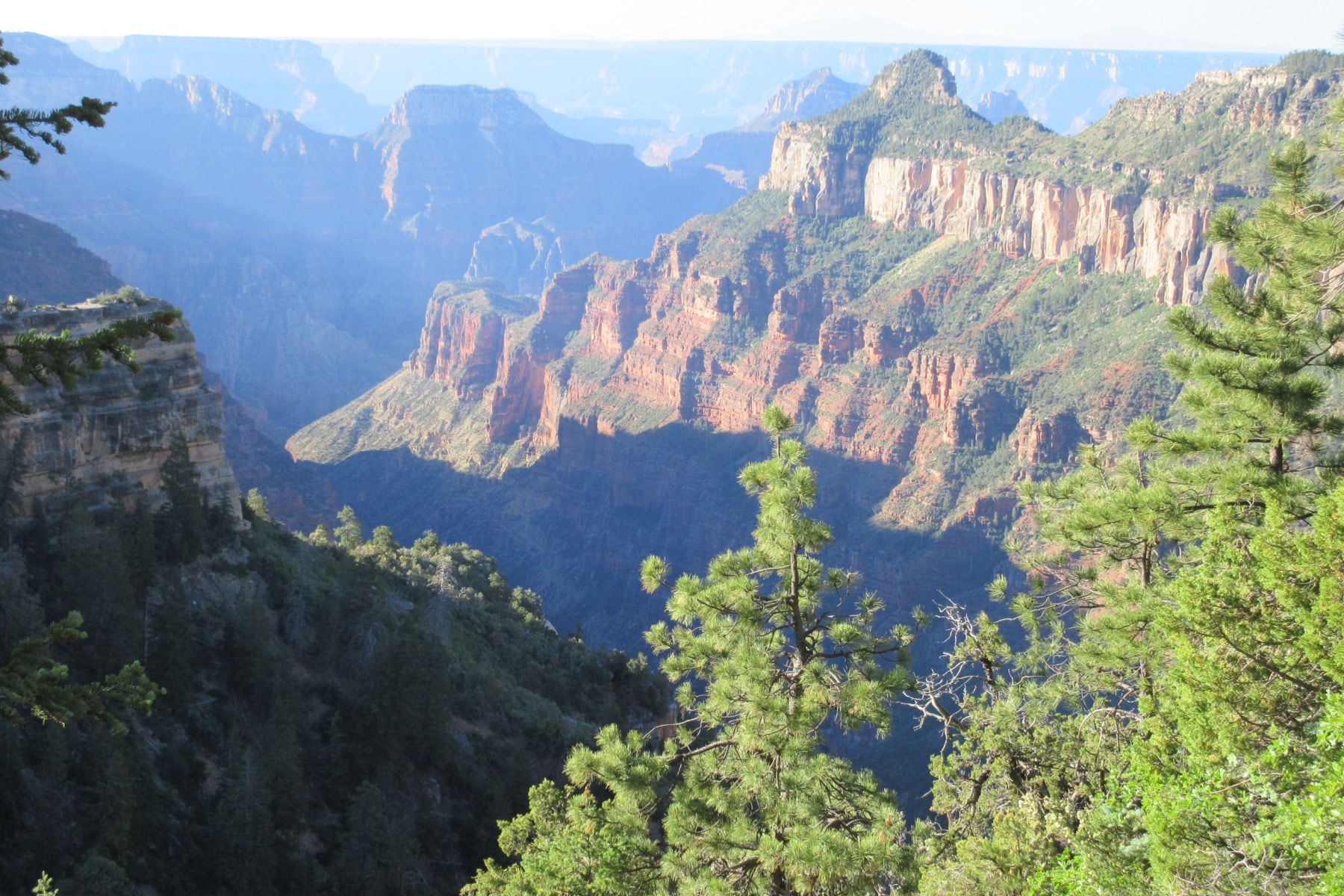
9. Cape Final Trail
Location: North Rim
- Distance: 4 miles round-trip
- Difficulty: Easy
- Elevation Change: 495 ft
- Time Required: 2 hours round-trip
In this case, I’m going to share a secret with you about the Cape Final Trail, among all the other details of the best hikes of Grand Canyon National Park.
First of all, most of this trail first takes you through a lush, shaded forest. Then, the final stretch to Cape Final gives you an incredible view that takes your breath away, coupled with a view of Angels Window in the distance.
The Cape Final trail is generally easy, but it gets rocky for the first 1/3 mile. Additionally, the slight incline up to Cape Final may make the uphill portions slightly more challenging, so be prepared. At the end of the trail is what I like to call a “Makes Your Momma Nervous” overlook, given that the drop-off is so steep.
Lastly, the big secret. There’s one backcountry campsite here right at the edge of the rim (permit required, obviously). Position your tent right, and you’ll watch the sun rise and set in one of the best campsites in the Grand Canyon.

8. Point Imperial Trail
Location: North Rim
- Distance: 4 miles round-trip
- Difficulty: Easy
- Elevation Change: 442 ft
- Time Required: 2 hours round-trip
This easy(ish) trail takes you through areas affected following the 2000 Outlet Fire, providing a unique opportunity to witness the regrowth and recovery of the natural landscape. It’s also a shorter option to hike to Point Imperial without taking the much longer Ken Patrick Trail, as noted above.
As you traverse the trail, you’ll observe the striking contrasts between the burned areas coupled with the flourishing forests. By all means, check it out in the spring or summer to catch glimpses of regrowth and wildflowers!
Just be mindful of the trail conditions and follow any posted guidelines. Sections of the trail may still exhibit the effects of the wildfire.
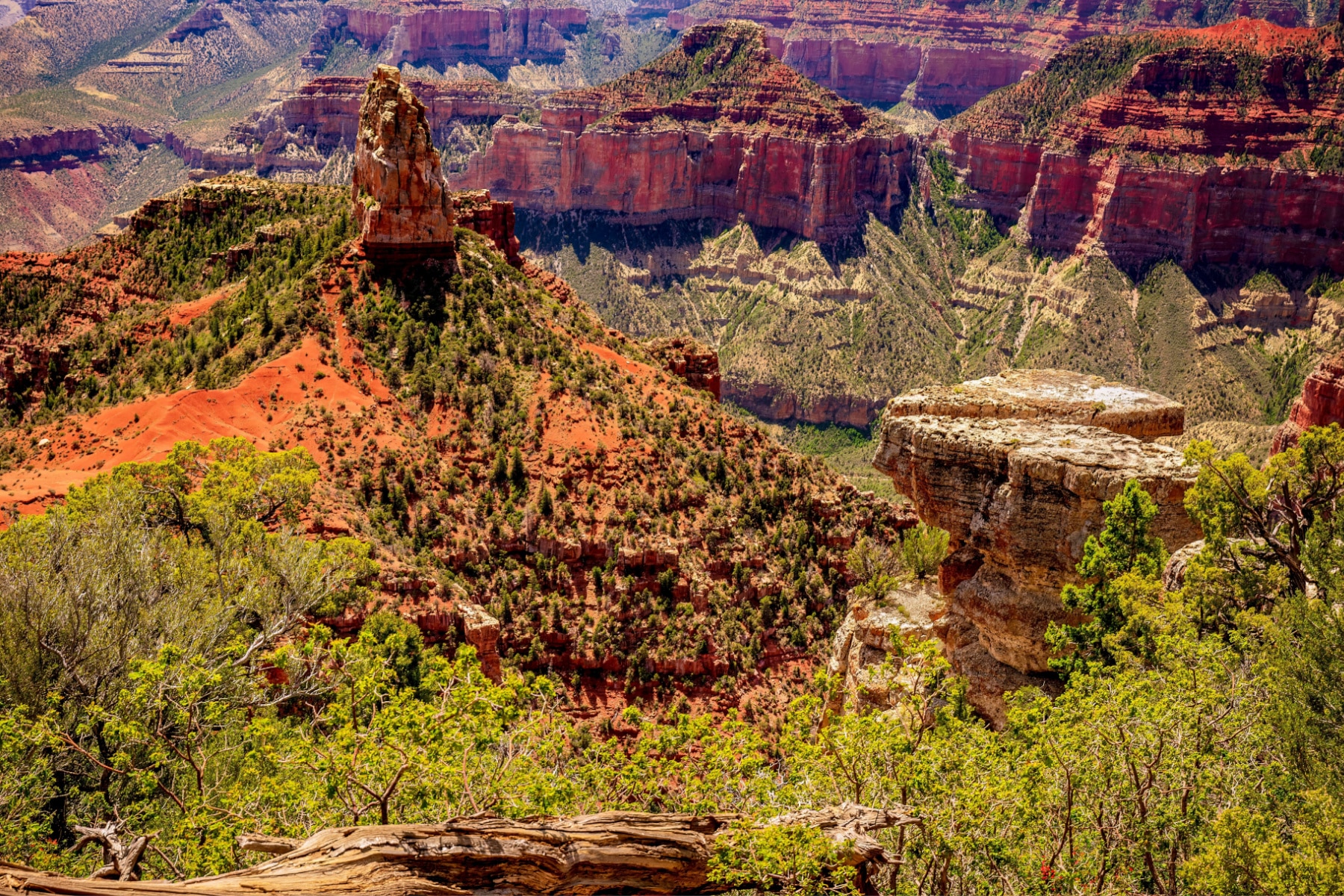
7. Cliff Springs Trail
Location: North Rim
- Distance: 1 mile round-trip
- Difficulty: Easy
- Elevation Change: 252 ft
- Time Required: 30 minutes round-trip
Although the Cliff Springs Trail is short it is one of the more beautiful and nail-biting best hikes in the Grand Canyon. One quick walk through a pristine forest with a natural spring at the end? Sign us up! I absolutely love the ease of this trail coupled with the challenge it presents.
Eventually, the trail turns into a thread of space in the canyon walls. In addition, you’ll also pass a native home built into the canyon rock, but you shouldn’t try to go inside. Even though the trail isn’t that long, it has some steep drops following the path.
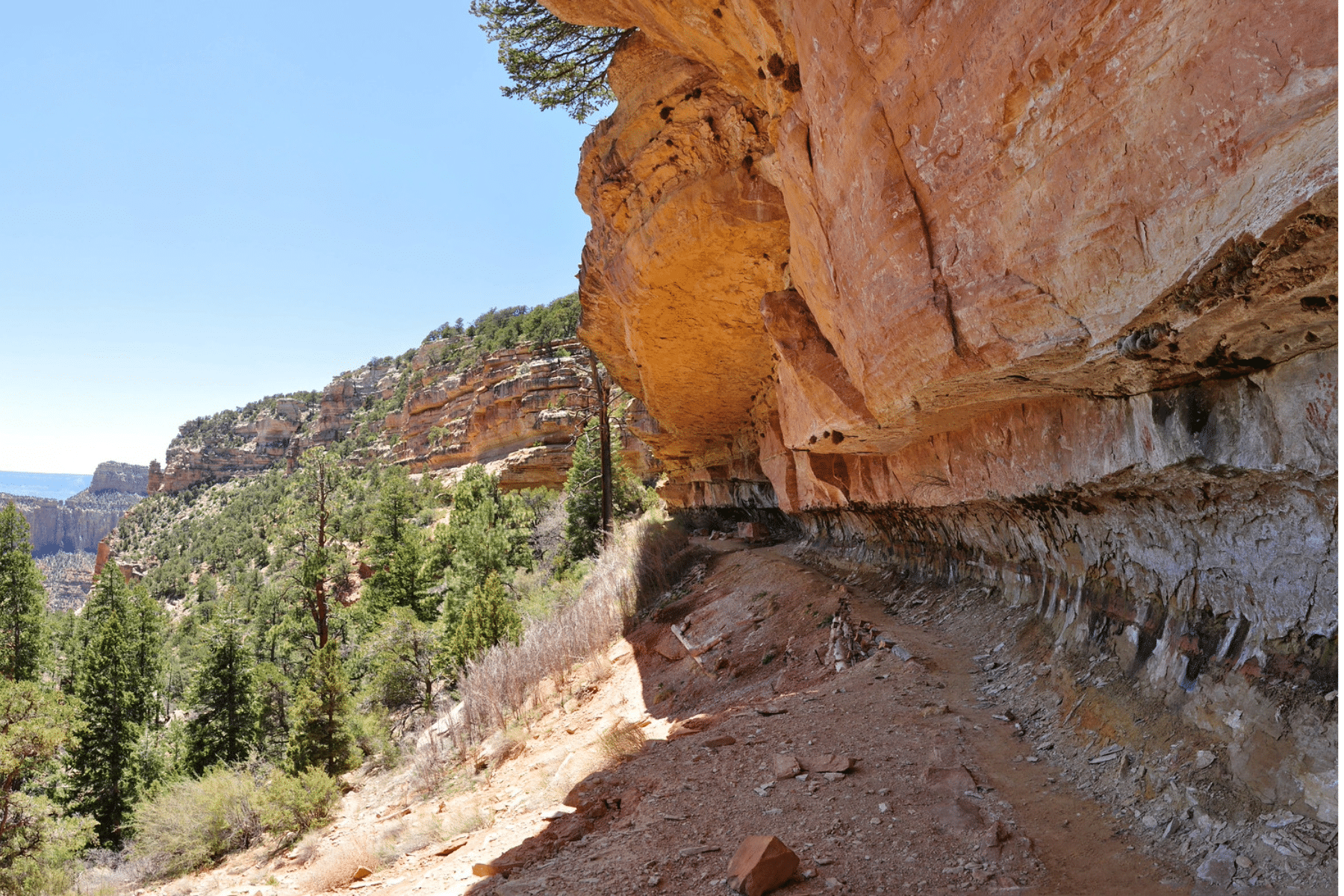
6. Grandview Trail
Location: Canyon side of Grandview Point on Desert View Drive
- Distance: 8 miles (round trip)
- Difficulty: Moderate to Strenuous
- Elevation Change: 2,732 ft
- Time Required: 5-8 hours
Indeed, the Grandview Trail might be the toughest of the best hikes in Grand Canyon National Park. As a matter of fact, those who know these trails best say it’s exponentially more dangerous than Bright Angel Trail or the South Kaibab.
“Built in 1893 as a mining route, this rocky, exposed, and strenuous trail requires
NPS GRANDVIEW TRAIL GUIDE
caution. Large steps and extreme dropoffs intensify the steepness of the trail.”
In addition to the challenging hike, you’ll pass by an off-limits section due to natural elements that are radioactive. Furthermore, the trail takes you to Horseshoe Mesa, where you can add the Tonto Trail or detour off to Cottonwood Creek.
DO NOT DRINK OR TOUCH THE WATER HERE. It is radioactive, with high levels of arsenic.
At the same time, there’s an “easier version” of this tough hike: just hike (scramble, climb) down to the Coconino Saddle. I’m not embarrassed to admit this was my limit for this trail on account of how tough it was, even though it was only 1.1 miles down. It still took me three hours, as much as I wanted to finish it.



5. Rim Trail
Location: South Rim
- Distance: Approximately 13 miles from South Kaibab Trailhead to Hermits Rest
- Difficulty: Easy
- Elevation Change: 583 ft
- Time Required: 4 hours 30 minutes
The Rim Trail is a long trail that stretches from the Village area to Hermits Rest, so you can hike as much or as little as you want. Basically, you can begin from any viewpoint in the Village or along Hermit Road – it is still one of the best hikes Grand Canyon National Park has for those wanting an easy hike in any case.
NOTE: This is not the same thing as the Rim-to-Rim trail.
In the event that 13 miles is too much for you, you can undoubtedly cut that hike short. If you want to use the shuttle, several stops are along the way. Then, you can walk to the next scenic view. By all means, use this resource. Besides, you might need a quick escape if the heights or heat are getting to you. After that, you can even take the shuttle between viewpoints.
As much as there is to see, here are a few of the best stops on this trail.
- Mohave Point: Great sunset views.
- Pima Point: You can see and hear the roar of the Colorado River.
- Hopi Point: Extends farther into the canyon than any other on this trail.
Another key point is that the Rim Trail has paved and unpaved sections, with some portions accessible for individuals with mobility challenges or those pushing strollers.
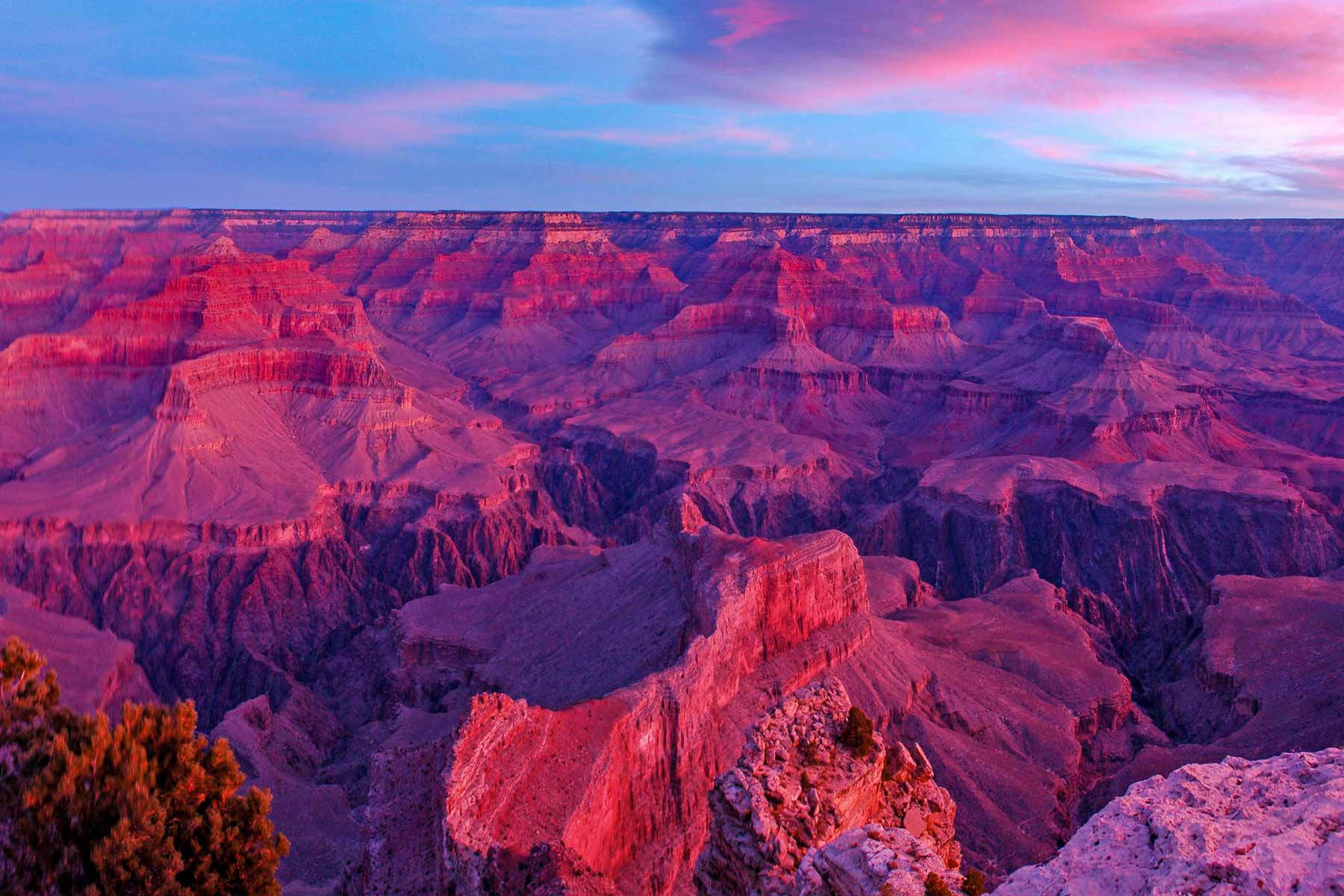
4. Hermit Trail (2 Trails)
Location: South Rim
Hermit’s Rest to Santa Maria Spring:
- Distance: 4 miles (round trip)
- Difficulty: Moderate to Strenuous
- Elevation Change: 1,751 ft
- Time Required: 3-5 hours
To Dripping Springs:
- Distance: 6 miles (round trip)
- Difficulty: Strenuous
- Elevation Change: 2,135 ft
- Time Required: 5-7 hours
The Hermit Trail is a steeper, more challenging hike preferred among more experienced hikers looking for the best hikes in the Grand Canyon. With two primary hiking destinations, Santa Maria Spring and Dripping Springs, that is to say, this trail is tough but rewarding.
First of all, the hike to Santa Maria Spring from Hermit’s Rest is about 4 miles round trip. Due to its unmaintained nature and steep terrain, you’ll want to hike with additional care.
The Hermit of Hermit Trail
Not only was Louis Boucher nicknamed the “Hermit” because he claimed and lived off the land in this rural region, but he also preferred the company of his white mule, Calamity Jane, instead of humans.
All that said, he was actually quite social in his community and even gave tours in the early days of Grand Canyon tourism.
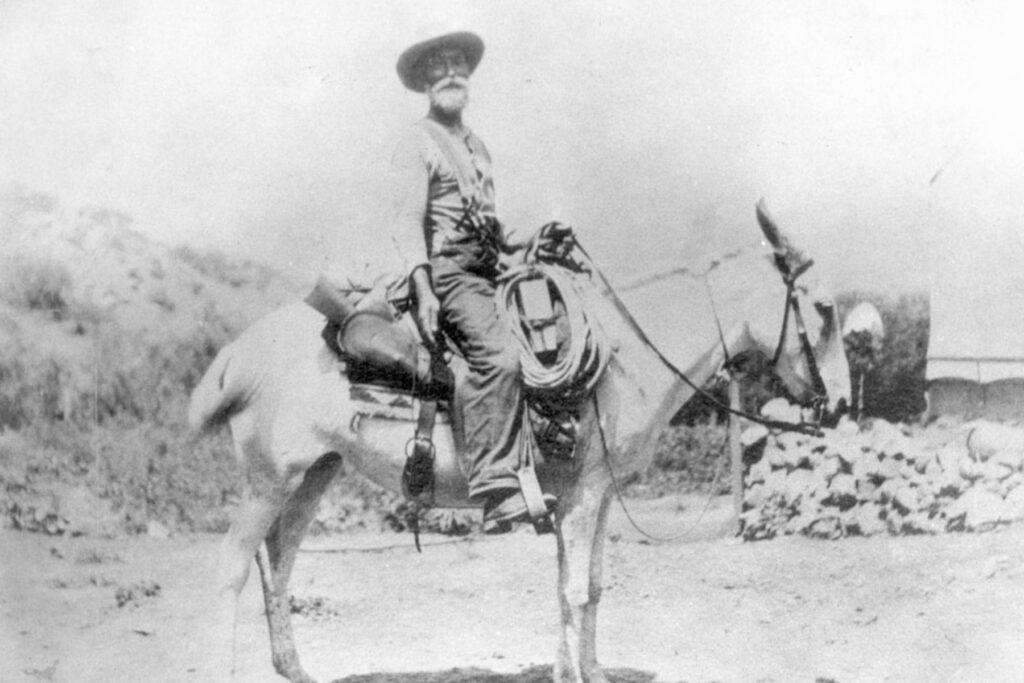
Secondly, for those seeking a more demanding adventure, the hike to Dripping Springs spans six miles round trip.
If you have any doubts about your hiking ability before you go, don’t take the Hermit Trail!
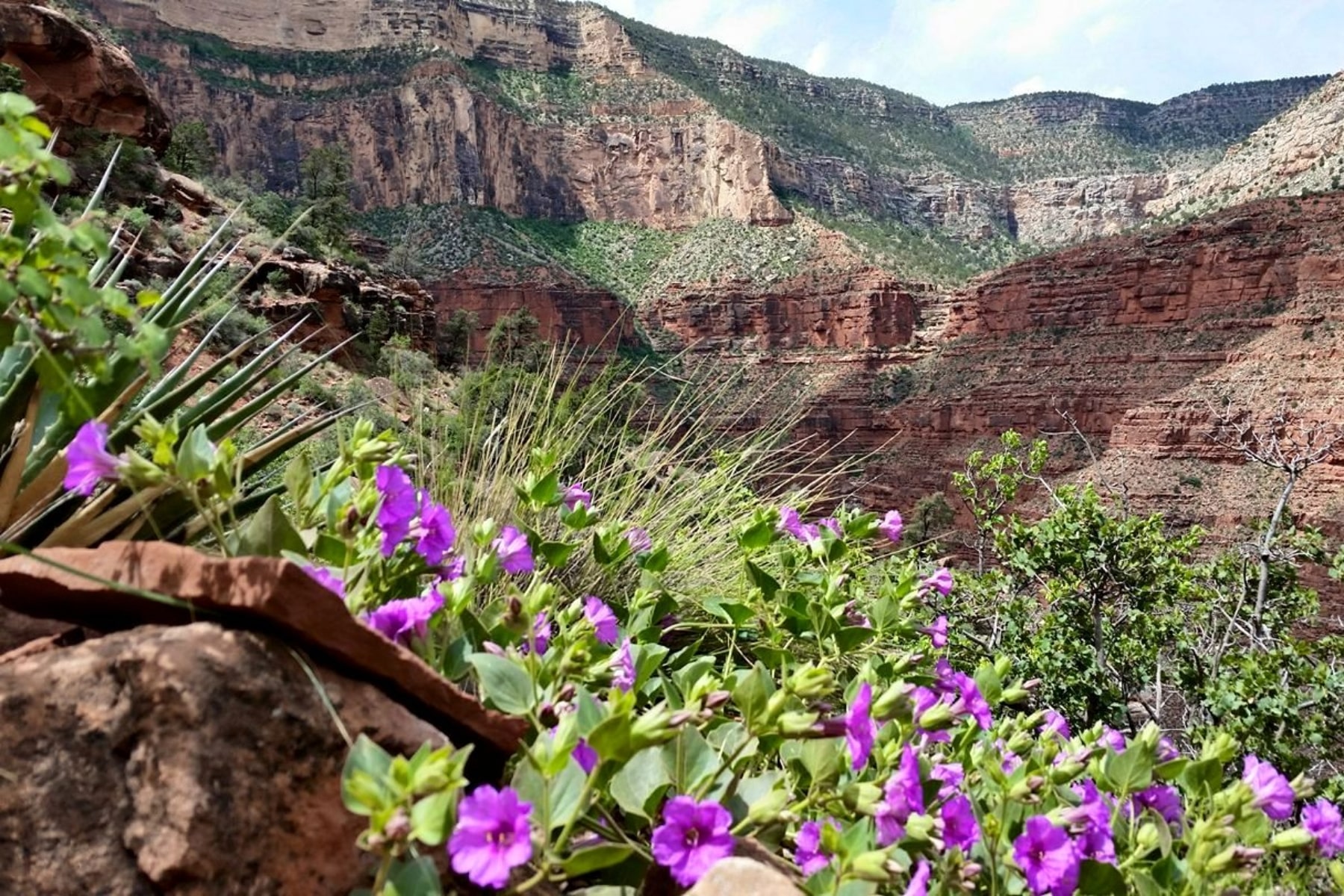
3. North Kaibab (4 Trails)
Location: Near the North Rim Visitor Center
Coconino Overlook:
- Distance: 1.5 miles round-trip
- Difficulty: Easy
- Elevation Change: Approximately 200 feet
- Time Required: 1-2 hours
Supai Tunnel:
- Distance: 4 miles round-trip
- Difficulty: Moderate
- Elevation Change: Approximately 600 feet
- Time Required: 2-3 hours
Roaring Springs:
- Distance: 9.4 miles round-trip
- Difficulty: Strenuous
- Elevation Change: 3,050 feet
- Time Required: 7-8 hours
Colorado River (Not recommended as a day hike):
- Distance: 28 miles round-trip
- Difficulty: Extremely Strenuous
- Elevation Change: Almost 6,000 feet
- Time Required: Multiple days
The North Kaibab trail is one of the best hikes in Grand Canyon National Park to go river-to-rim or rim-to-rim, but as noted above, there are several iterations you can take to make the trail shorter.
As a matter of fact, most day hikers will be satisfied with a hike to Coconino Overlook, spanning 1.5 miles round-trip, or to Supai Tunnel, which is 4 miles round-trip.
For those seeking a thrilling adventure, try the hike to the Roaring Springs. This demanding hike, taking a full day of around 7-8 hours to complete, challenges even the best hikers. To illustrate, here’s a preview of what you’ll find.
As I have noted above, this trail is closed in the winter. You wouldn’t want to risk it with the snow and ice that falls on this side of the canyon anyway for this reason.
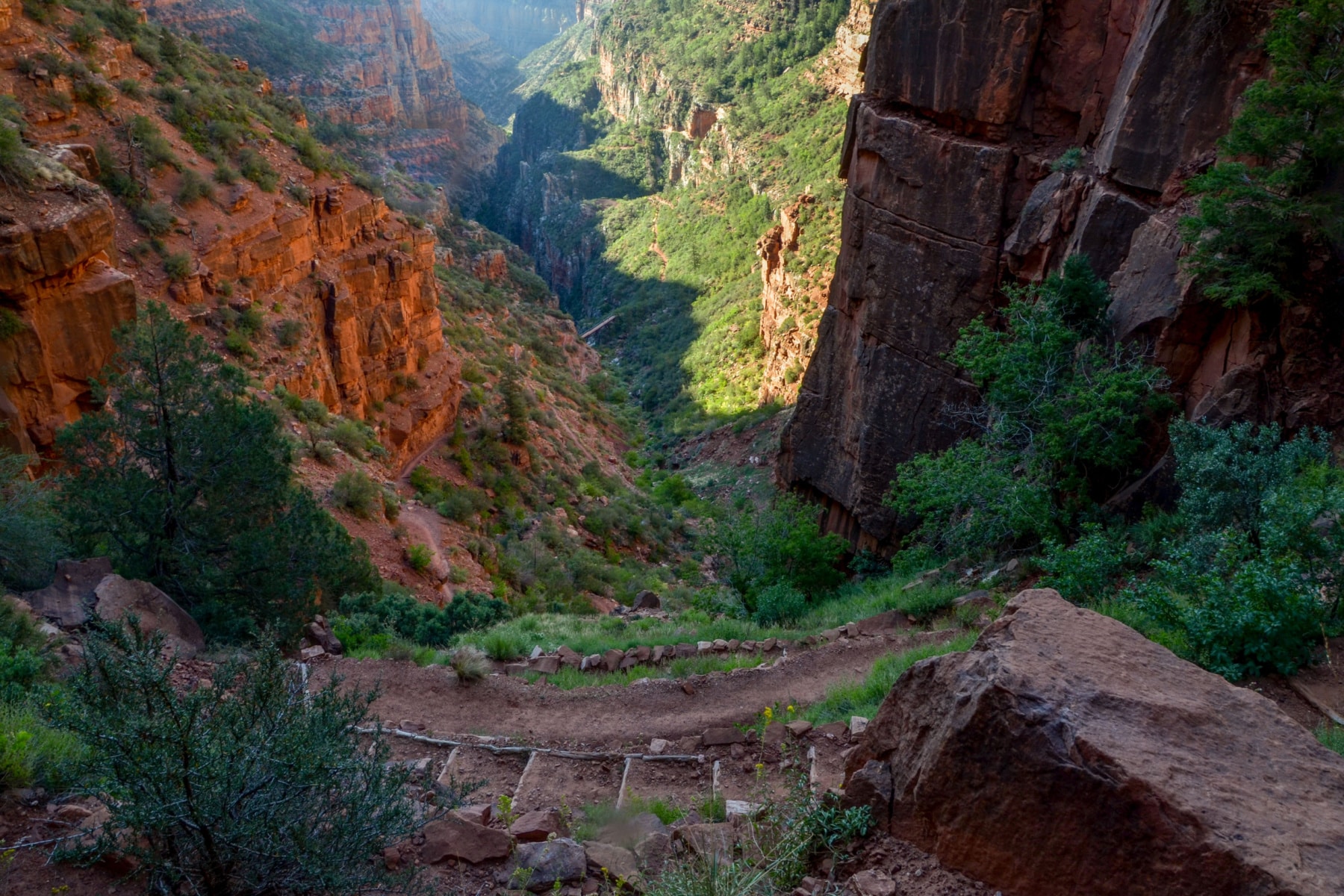
2. South Kaibab Trail
Location: South Rim
- Distance: 6.8 miles (one way)
- Difficulty: Strenuous
- Elevation Change: 4,780 feet
- Time Required: 4-6 hours (one way)
Being that so many people take Bright Angel Trail on the South Rim, the South Kaibab Trail is a shorter route to the river. It’s also one of the best hikes in the Grand Canyon to avoid crowds. By and large, the South Kaibab Trail views are just as incredible as well.
As much as this trail is wonderful, there is very little shade and no water stations. For the most part, the only mules you’ll find here are taking supplies to Phantom Ranch near the river.
Additionally, the steepness of the trail can be deceiving when descending. Overall, plan for the return hike to take twice as long as the descent.





1. Bright Angel Trail
Location: North Rim of Grand Canyon National Park
- Distance: 15.3 miles round-trip
- Difficulty: Hard
- Elevation Change: 4,380 ft
- Time Required: Approximately 30 minutes round-trip
- Guide: My deeper dive into Bright Angel Trail.
The Bright Angel Trail in the Grand Canyon is renowned as one of the premier hiking experiences in the United States and often tops the list of best hikes Grand Canyon National Park offers.
The Bright Angel Point Trail offers stunning views, well-maintained paths, rest stops throughout the first three miles and water availability. It descends from the South Rim to the Colorado River, and hikers can choose various distances and destinations based on their skill level and time constraints.
- 1.5-Mile Resthouse: This is the typical day hike for the average hiker. You get the switchbacks’ thrill without the entire trail’s exhaustion.
- 3-Mile Resthouse: Continuing down, you’ll reach the 3-Mile Resthouse, another opportunity to rest, hydrate, and cool off.
- Havasupai Garden: At around 4.6 miles from the trailhead, you’ll arrive at Havasupai Garden, formerly known as Indian Garden. Campgrounds for those with permits are available here. At the same time, you don’t want to press a day hike any further than this.
- Colorado River: Descending further, you’ll eventually reach the mighty Colorado River, around 7.5 miles from the trailhead. This rim-to-river day hike is strongly discouraged by park officials.
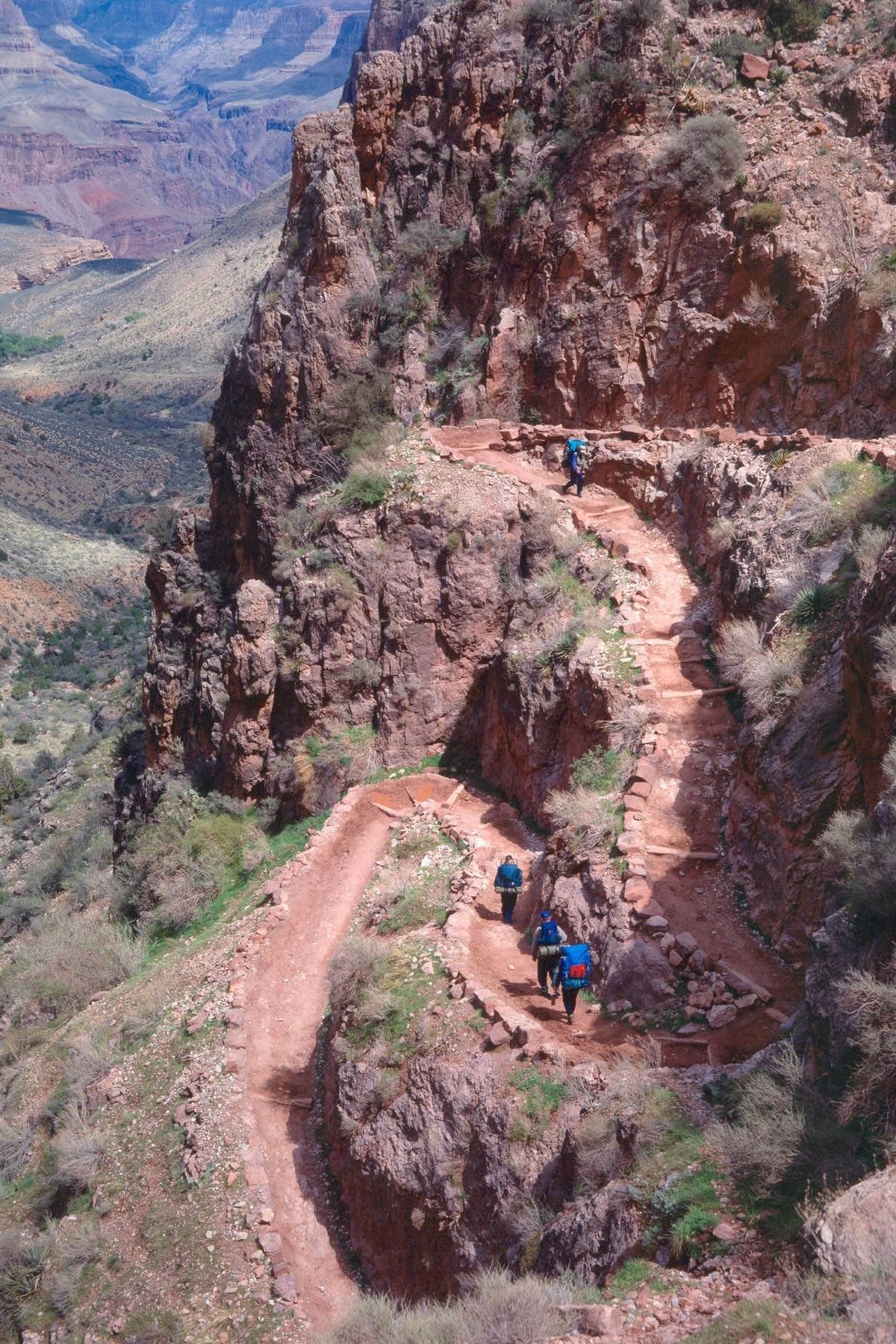
Map of Best Hikes Grand Canyon
Summary Best Hikes Grand Canyon
- Bright Angel Trail
- South Kaibab Trail
- North Kaibab Trail
- Hermit Trail
- Rim Trail
- Grandview Trail
- Cliff Springs Trail
- Point Imperial Trail
- Cape Final Trail
- Wildforss Trail
- Uncle Jim Trail
- Ken Patrick Trail
- Bridle Trail
- Tanner Trail
- Transept Trail
Grand Canyon Rim-to-Rim Trail
The toughest hike in Grand Canyon National Park involves going from Rim to Rim, which can be done using either the Bright Angel Trail or South Kaibab Trail paired with the North Kaibab Trail.
In brief, it’s not for the faint of heart, and you should be in prime physical fitness and lucky as a lottery winner to score the permits you need in order to make the trek. Click the photo below to get the most honest guide you’ll find online, not to mention all the major stops along the way.
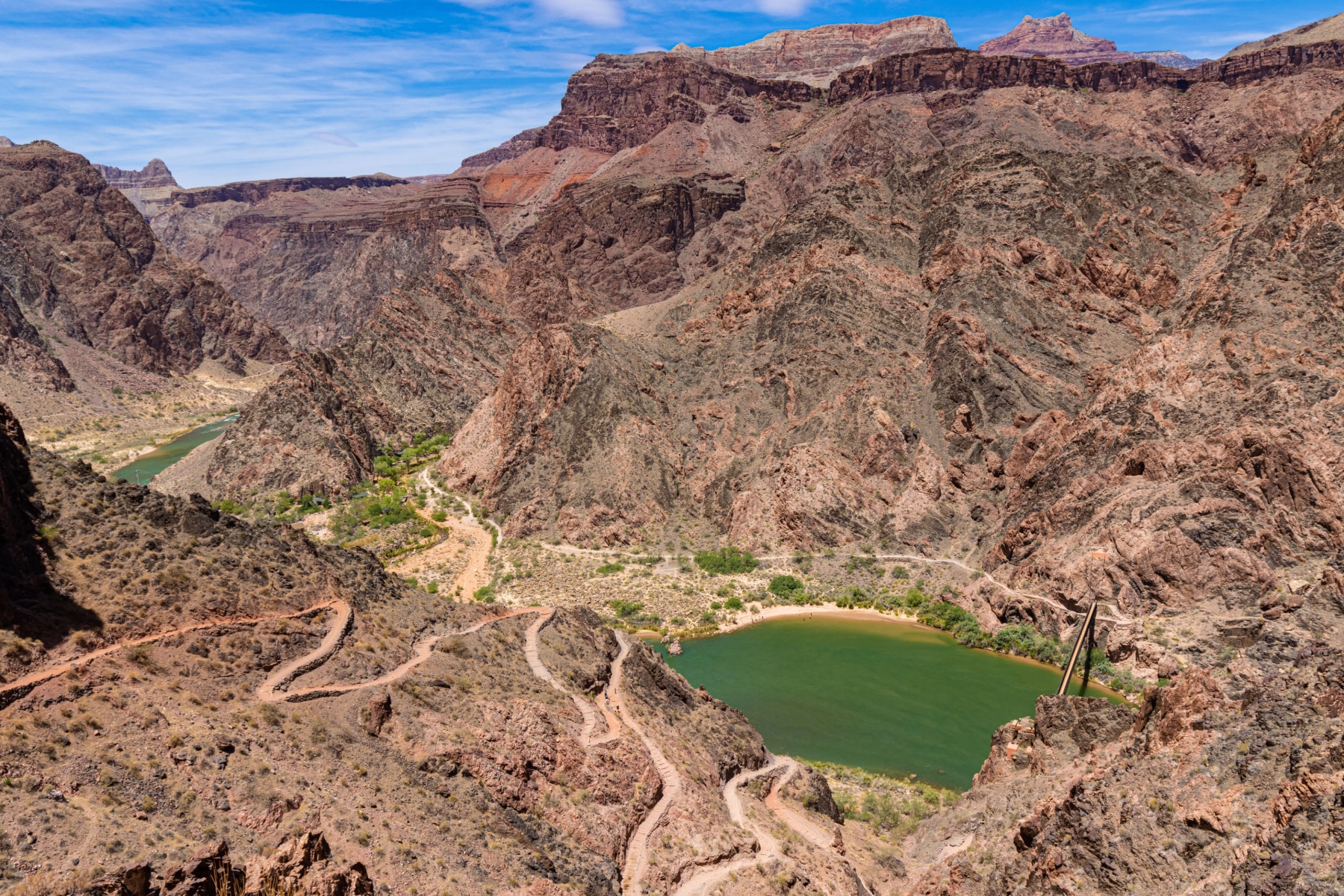
Pin 15 Best Hikes in the Grand Canyon
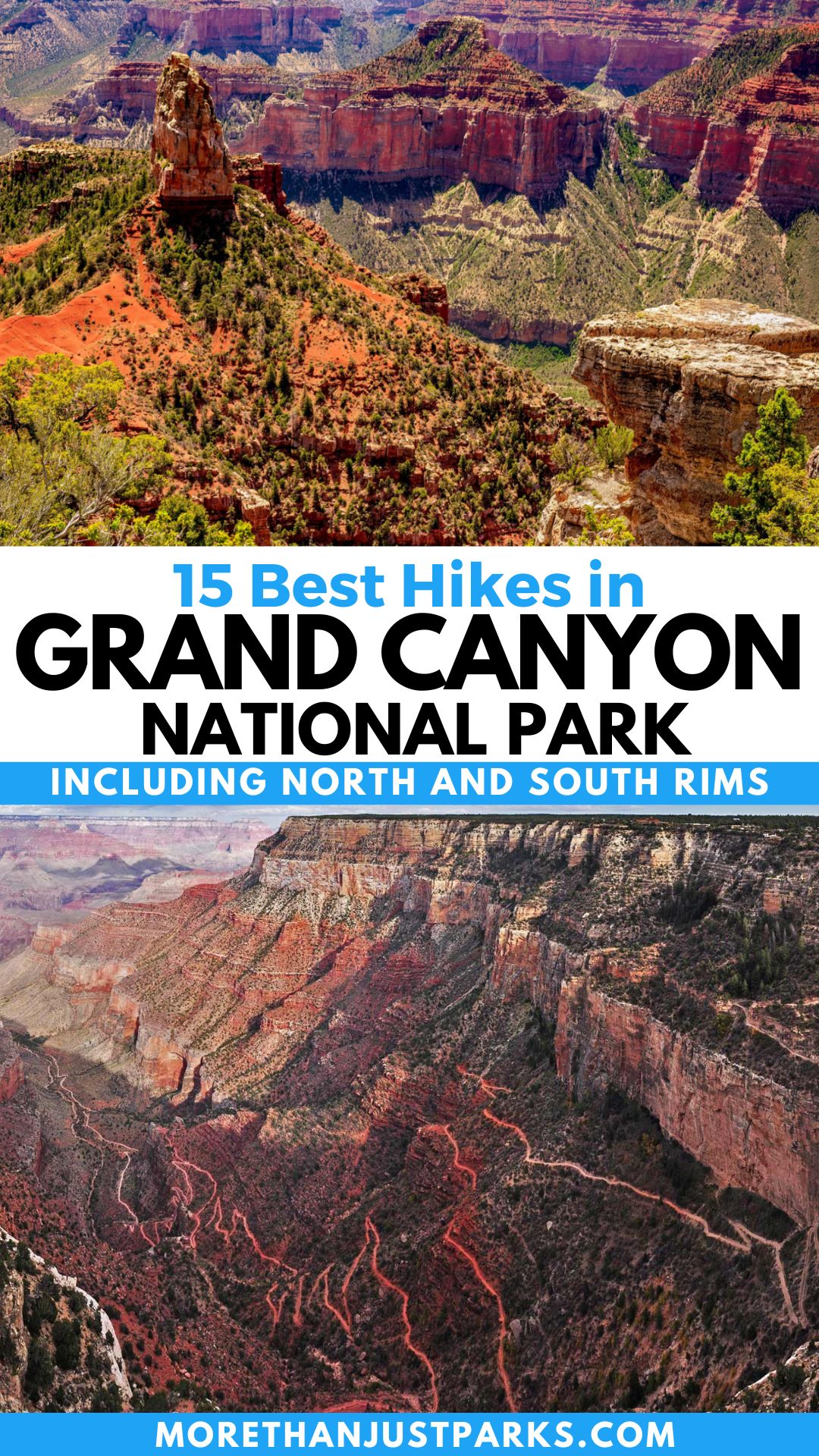
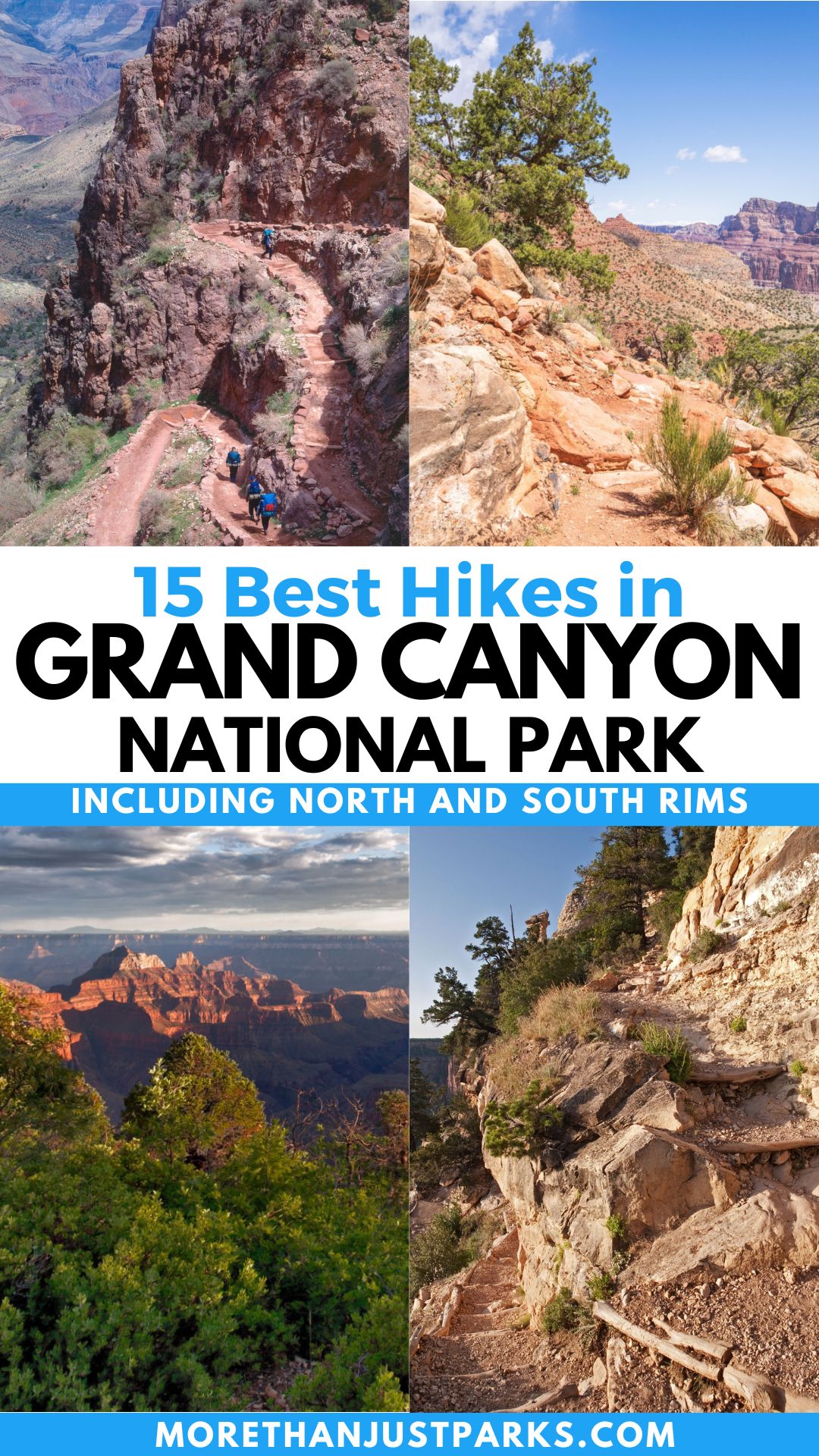
Helpful Related Articles
Things to Do North Rim Grand Canyon: 15 Epic Things to Do at the North Rim of the Grand Canyon
Grand Canyon Viewpoints: 20 Best Views of the Grand Canyon (National Park)
Grand Canyon South Rim Things to Do: 15 Amazing Things to Do at the Grand Canyon South Rim
Things to Do at the Grand Canyon: 20 Best Things to Do at Grand Canyon National Park
Closest Cities to the Grand Canyon: 10 Closest Cities Near the Grand Canyon
Grand Canyon Facts: 15 Fascinating Grand Canyon National Park Facts
Grand Canyon in Winter: Visiting the Grand Canyon in December (Winter Guide)
Desert View Watchtower: Explore the Historic Desert View Watchtower
Arizona National Parks: 24 Epic Arizona National Parks to Visit (Photos + Guide)
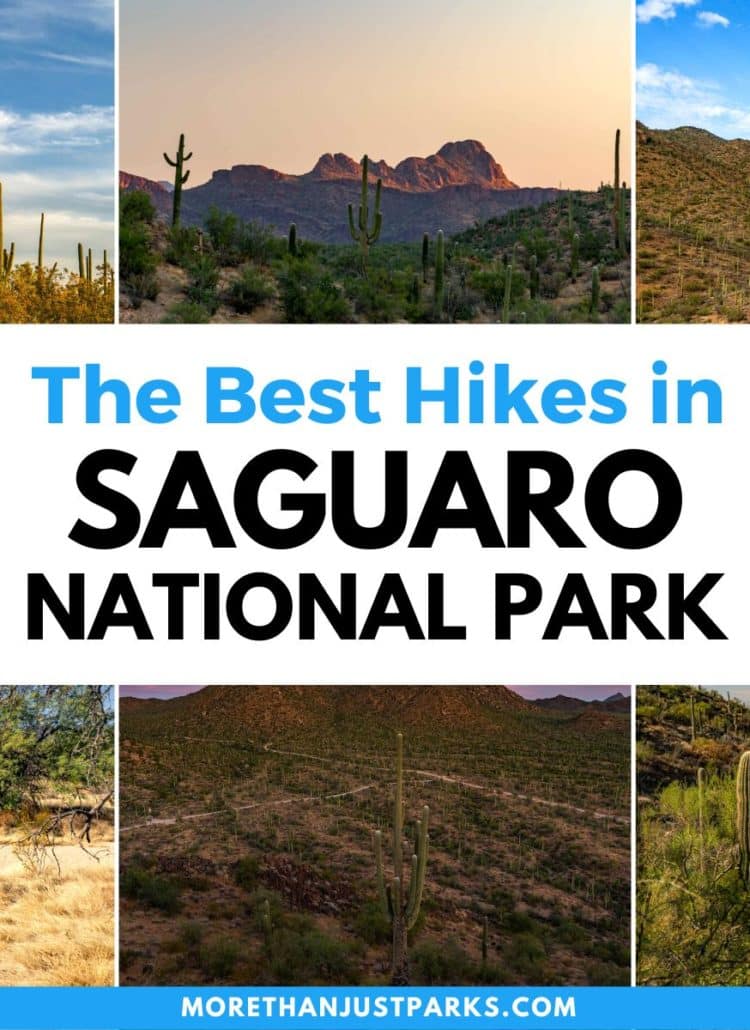
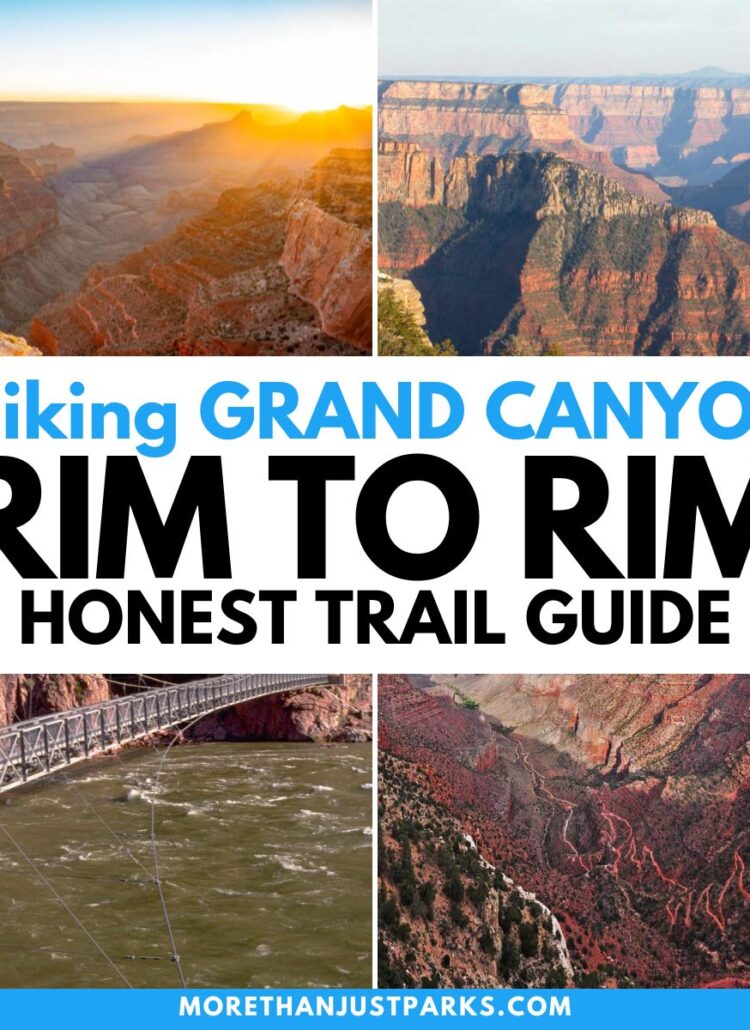
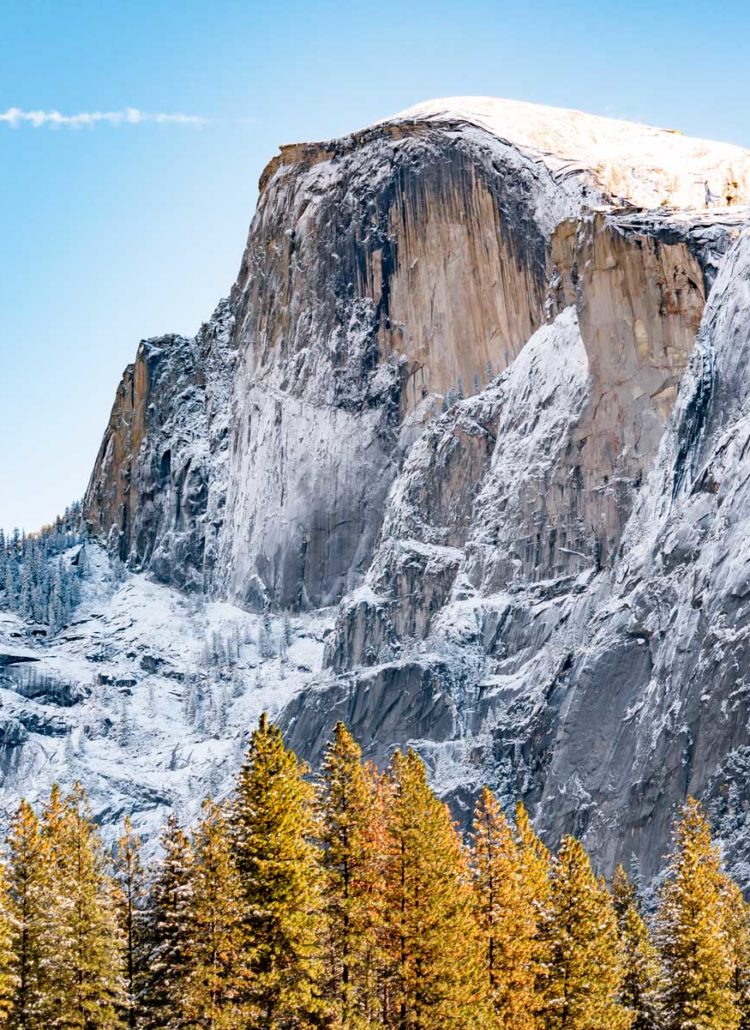


Leave a Reply